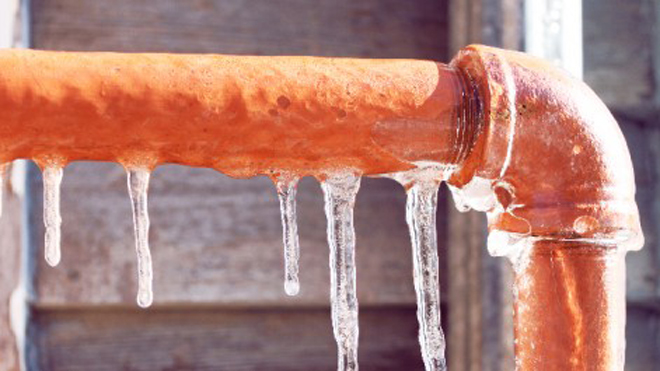Prevent Frozen Plumbing in Winter: Expert Advice
Prevent Frozen Plumbing in Winter: Expert Advice
Blog Article
This post below pertaining to Prevent Frozen Pipes is pretty much motivating. Read on and make your own personal ideas.

Cold weather can wreak havoc on your pipes, specifically by freezing pipelines. Right here's just how to avoid it from occurring and what to do if it does.
Introduction
As temperatures decline, the danger of frozen pipelines rises, potentially leading to pricey repair services and water damage. Understanding just how to avoid icy pipes is essential for home owners in chilly climates.
Comprehending Frozen Pipelines
What causes pipes to ice up?
Pipes ice up when exposed to temperature levels below 32 ° F (0 ° C) for expanded durations. As water inside the pipelines freezes, it expands, taxing the pipe wall surfaces and possibly causing them to burst.
Threats and problems
Frozen pipes can bring about water supply disturbances, residential or commercial property damages, and costly repair services. Ruptured pipelines can flood homes and cause comprehensive architectural damages.
Indicators of Frozen Piping
Recognizing icy pipes early can avoid them from rupturing.
Exactly how to determine frozen pipes
Seek lowered water circulation from taps, unusual odors or noises from pipes, and visible frost on exposed pipelines.
Avoidance Tips
Protecting susceptible pipes
Cover pipelines in insulation sleeves or utilize heat tape to shield them from freezing temperatures. Concentrate on pipes in unheated or exterior locations of the home.
Heating strategies
Maintain indoor spaces properly warmed, particularly locations with pipes. Open closet doors to enable cozy air to distribute around pipelines under sinks.
Protecting Outside Pipes
Garden pipes and outdoor faucets
Detach and drain pipes garden hose pipes prior to winter. Set up frost-proof faucets or cover outside faucets with shielded caps.
What to Do If Your Pipes Freeze
Immediate activities to take
If you presume frozen pipes, keep taps available to alleviate pressure as the ice melts. Make use of a hairdryer or towels taken in hot water to thaw pipelines gradually.
Long-Term Solutions
Architectural changes
Think about rerouting pipelines away from exterior wall surfaces or unheated areas. Include added insulation to attics, cellars, and crawl spaces.
Updating insulation
Invest in high-grade insulation for pipes, attics, and wall surfaces. Correct insulation helps maintain constant temperature levels and lowers the risk of frozen pipes.
Final thought
Protecting against icy pipes requires proactive actions and fast reactions. By understanding the reasons, indications, and preventive measures, property owners can safeguard their plumbing throughout cold weather.
Helpful Tips to Prevent Frozen Pipes this Winter
UNDERSTANDING THE BASICS: WHY PIPES FREEZE AND WHY IT’S A PROBLEM
Water freezing inside pipes is common during the winter months, but understanding why pipes freeze, and the potential problems it can cause is crucial in preventing such incidents. This section will delve into the basics of why pipes freeze and the associated problems that may arise.
THE SCIENCE BEHIND FROZEN PIPES
When water reaches freezing temperatures, it undergoes a physical transformation and solidifies into ice. This expansion of water as it freezes is the primary reason pipes can burst. As the water inside the pipe freezes, it expands, creating immense pressure on the walls. If the pressure becomes too great, the pipe can crack or rupture, leading to leaks and water damage.
FACTORS THAT CONTRIBUTE TO PIPE FREEZING
Low Temperatures: Extremely cold weather, especially below freezing, increases the risk of pipes freezing. Uninsulated or Poorly Insulated Pipes: Pipes located in unheated areas, such as basements, crawl spaces, or attics, are more prone to freezing. Insufficient insulation or lack of insulation altogether exacerbates the problem. Exterior Wall Exposure: Pipes running along exterior walls are susceptible to freezing as they encounter colder temperatures outside. Lack of Heating or Temperature Regulation: Inadequate heating or inconsistent temperature control in your home can contribute to frozen pipes. PROBLEMS CAUSED BY FROZEN PIPES
- Pipe Bursting: As mentioned earlier, the expansion of water as it freezes can cause pipes to burst, resulting in significant water damage.
- Water Damage: When pipes burst, it can lead to flooding and water damage to your property, including walls, ceilings, flooring, and personal belongings.
- Structural Damage: Prolonged exposure to water from burst pipes can compromise the structural integrity of your home, leading to costly repairs.
- Mold and Mildew Growth: Excess moisture from water damage can create a favorable environment for mold and mildew growth, posing health risks to occupants.
- Disrupted Water Supply: Frozen pipes can also result in a complete or partial loss of water supply until the issue is resolved.
WHY CERTAIN PIPES ARE MORE PRONE TO FREEZING
- Location: Pipes located in unheated or poorly insulated areas, such as basements, crawl spaces, attics, or exterior walls, are at higher risk of freezing.
- Exterior Pipes: Outdoor pipes, such as those used for irrigation or exposed plumbing, are particularly vulnerable to freezing as they are directly exposed to the elements.
- Supply Lines: Pipes that carry water from the main water supply into your home, including the main water line, are critical to protect as freezing in these lines can affect your entire plumbing system.
- Underground Pipes: Pipes buried underground, such as those connected to sprinkler systems or outdoor faucets, can be susceptible to freezing if not properly insulated.
https://busybusy.com/blog/helpful-tips-to-prevent-frozen-pipes-this-winter/

I came across that blog entry about 6 Ways to Prevent Frozen Pipes when doing a lookup on the web. Be sure to take the time to share this page if you liked it. Thank-you for going through it.
Schedule Today! Report this page